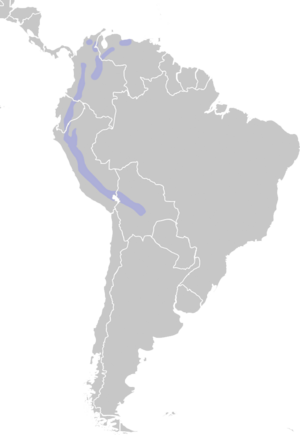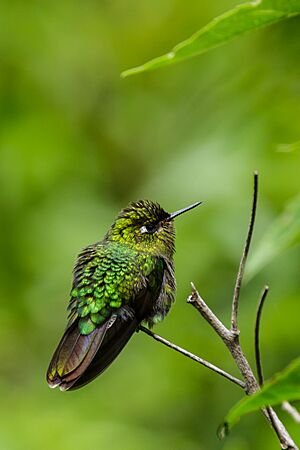Tyrian metaltail facts for kids
Quick facts for kids Tyrian metaltail |
|
|---|---|
 |
|
| Metallura tyrianthina tyrianthina, Colombia | |
| Conservation status | |
| Scientific classification | |
| Genus: |
Metallura
|
| Species: |
tyrianthina
|
 |
|
The Tyrian metaltail (Metallura tyrianthina) is a type of hummingbird. It belongs to a group of hummingbirds called the brilliants and coquettes. You can find this bird in countries like Bolivia, Colombia, Ecuador, Peru, and Venezuela.
Contents
About the Tyrian Metaltail Family
The Tyrian metaltail has seven different types, called subspecies. Think of subspecies as slightly different versions of the same animal. They might have small differences in their looks or where they live.
Here are the different subspecies:
- M. t. districta
- M. t. chloropogon
- M. t. oreopola
- M. t. tyrianthina (This is the main one, called the "nominate" subspecies)
- M. t. quitensis
- M. t. septentrionalis
- M. t. smaragdinicollis
Scientists have studied these birds for a long time. Some thought a couple of these subspecies were actually separate species. However, most scientists now agree they are all part of the Tyrian metaltail family.
What Does a Tyrian Metaltail Look Like?
This hummingbird is about 9 to 10 centimeters (3.5 to 4 inches) long. It weighs between 2.7 and 5.1 grams (about 0.1 to 0.18 ounces). Both male and female Tyrian metaltails have a short, straight, black beak.
The Main Tyrian Metaltail (M. t. tyrianthina)
The male of the main subspecies has shiny green feathers on its back. Its belly is gray with lighter edges on the feathers. It has a bright emerald green throat. Its tail is a bit forked and shimmers with a bronze color.
The female of this subspecies also has green feathers on her back. Her throat and upper chest are orange-yellow with olive green spots. Her lower chest and belly are whitish with green spots. The tips of her outer tail feathers are whitish.
How Other Subspecies Are Different
- M. t. districta has a purple tail. The female of this type does not have spots on her belly.
- M. t. chloropogon has a coppery red tail. The male is almost all black, and the female has only a few spots on her throat.
- M. t. oreopola's tail is golden red. The male has coppery stripes on its back feathers. Its belly is green with light edges. The female has few spots on her throat.
- M. t. quitensis has a longer beak than the main subspecies. Its tail is bronze-olive.
- M. t. septentrionalis's tail is purple-blue with some green. The male's belly is white with bronze-olive spots.
- M. t. smaragdinicollis has a purple tail, similar to districta. However, the female's throat and upper chest have many spots, like the main subspecies.
Where Do Tyrian Metaltails Live?
Tyrian metaltails live in different parts of South America. Each subspecies tends to live in a specific area.
- M. t. districta lives in northern Colombia and northwestern Venezuela.
- M. t. chloropogon is found in the Venezuelan Coastal Range.
- M. t. oreopola lives in the Andes mountains of Venezuela.
- M. t. tyrianthina ranges from southern Venezuela through Colombia and Ecuador into northern Peru.
- M. t. quitensis is found in northwestern Ecuador.
- M. t. septentrionalis lives on the western side of the Peruvian Andes.
- M. t. smaragdinicollis is found on the eastern side of the Peruvian Andes and across central Bolivia.
These hummingbirds like to live in humid, open areas. This includes forests where trees have grown back (secondary forest) and misty cloudforests. They also live in mossy areas near the treeline and in "elfin forests," which have small, twisted trees. Sometimes, they are found at the edges of open grasslands called páramo. They usually live at high elevations, from about 1,500 to 4,200 meters (about 4,900 to 13,800 feet) above sea level. Most often, you'll see them between 2,500 and 3,300 meters (about 8,200 to 10,800 feet).
Tyrian Metaltail Behavior
Movement
Tyrian metaltails move to different elevations depending on the season. They can sometimes be found as low as 600 meters (about 2,000 feet) in Venezuela.
Feeding Habits
These hummingbirds look for food in the tops of bushes and medium-sized trees. Male birds will protect their feeding areas. They drink nectar from many different kinds of flowers. They do this by hovering or clinging to the flower and putting their beak inside. Sometimes, they might even poke a hole in the base of the flower to get the nectar. They also catch small insects while flying.
Reproduction and Life Cycle
The breeding seasons for Tyrian metaltails change depending on where they live. Only the female builds the nest, sits on the eggs, and takes care of the baby birds. They usually start breeding when they are two years old.
The nest is shaped like an open cup. It is made from moss, lichens, and other plant materials. It might be lined with soft, cotton-like seeds. Nests are often placed in rocky spots or hung from roots on a dirt or rock wall. Females usually lay two eggs.
Vocalization (Sounds)
The Tyrian metaltail does not sing very often. Its song is a repeated series of weak, high-pitched, "lispy" notes. It sounds like "seek..sik..see..si..see..sip..see.......see..seek..see..see..."
They call more often when they are chasing other birds. These calls are "stuttering trills" and repeated squeaky notes. They sound like "trr..trr..trr..tsi-see-sew-sew...tsi-see-sew-sew..." They also make a short rattling sound and quick "tsit" or "pit" notes.
Is the Tyrian Metaltail Endangered?
The IUCN (International Union for Conservation of Nature) has listed the Tyrian metaltail as a species of "Least Concern." This means that it is not considered to be in danger of disappearing.
Even though we don't know the exact number of these birds, their population seems to be stable. They are common across their large habitat and are very numerous in some places. They seem to be less affected by human changes to the environment than other types of metaltails. They also live in many protected natural areas.



